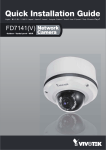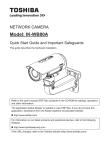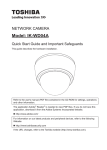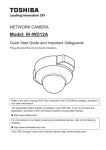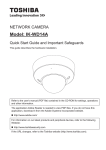Download Toshiba 625012200G Security Camera User Manual
Transcript
NETWORK CAMERA
Model: IK-WR12A
Quick Start Guide and Important Safeguards
This guide describes the hardware installation.
Refer to the user's manual (PDF file) contained in the CD-ROM for settings, operations
and other information.
The application Adobe Reader is needed to view PDF files. If you do not have this
application, download it from the Adobe Systems Incorporated website.
For information on our latest products and peripheral devices, refer to the following
Website:
n http://www.toshibasecurity.com
If the URL changes, refer to the Toshiba website (http://www.toshiba.com).
Introduction
FCC (USA)-INFORMATION
NOTE: This equipment has been tested and found to comply with the limits for a
Class A digital device, pursuant to Part 15 of the FCC Rules.
These limits are designed to provide reasonable protection against harmful
interference when the equipment is operated in a commercial environment. This
equipment generates, uses, and can radiate radio frequency energy and, if not
installed and used in accordance with the instruction manual, may cause harmful
interference to radio communications. Operation of this equipment in a residential
area is likely to cause harmful interference in which case the user will be required
to correct the interference at his own expense.
USER-INSTALLER CAUTION: Your authority to operate this FCC verified
equipment could be voided if you make changes or modifications not expressly
approved by the party.
This device complies with Part 15 of the FCC Rules. Operation is subject to the
following two conditions:
(1) This device may not cause harmful interference, and
(2) this device must accept any interference received, including interference that
may cause undesired operation.
This Class A digital apparatus complies with Canadian ICES-003.
Cet appareil numé rique de la classe A est conforme à la norme
NMB-003 du Canada
2
Thank you for purchasing the IK-WR12A Network Camera. Before you start using
the camera, read this quick start guide carefully to ensure correct usage. Once you
have finished reading this quick start guide, keep it in a convenient place for future
reference.
The design, specifications, software, and quick start guide contents are subject to
change without prior notice.
Terms and Trademarks
l The term "OS" is used in this manual to indicate operating systems compatible
with this product.
-- Windows® XP: Microsoft® Windows® XP operating system
-- Windows Vista®: Microsoft® Windows Vista® Business operating system
-- Windows 7®: Microsoft® Windows 7® Professional operating system
®
®
®
l The formal name of Windows is Microsoft Windows Operating System.
®
®
®
l Microsoft , Windows and Windows Vista are trademarks or registered
trademarks of Microsoft® Corporation in the United States and other countries.
l Adobe is a registered trademark and Adobe Reader is a trademark of Adobe
Systems Incorporated.
l Other product names appearing in this quick start guide may be trademarks or
registered trademarks of their respective holders.
NOTE
l The performance of the network camera may vary depending on the network
environment.
3
Table of Contents
Introduction
Introduction������������������������������������������������������������������������������������������������������� 2
FCC (USA)-INFORMATION���������������������������������������������������������������������������������������2
Terms and Trademarks����������������������������������������������������������������������������������������������3
Table of Contents��������������������������������������������������������������������������������������������� 4
Important Safeguards��������������������������������������������������������������������������������������� 5
Notes on Use and Installation�������������������������������������������������������������������������� 9
Setting the Network Camera Environment����������������������������������������������������� 10
Items needed for network camera monitoring���������������������������������������������������������10
Quick Start Guide
Contents����������������������������������������������������������������������������������������������������������11
Physical Description �������������������������������������������������������������������������������������� 12
Hardware Installation ������������������������������������������������������������������������������������� 14
Network Deployment�������������������������������������������������������������������������������������� 17
Assigning IP Address�������������������������������������������������������������������������������������� 19
Retrieving Images������������������������������������������������������������������������������������������ 20
Adjusting the Lens������������������������������������������������������������������������������������������ 21
Completion����������������������������������������������������������������������������������������������������� 22
4
Important Safeguards
1. Read Instructions
Read all the safety and operating instructions before operating the product.
2. Retain Instructions
Retain the safety instructions and user's manual for future reference.
3. Warnings
Comply with all warnings on the product and in the user's manual.
4. Follow Instructions
Follow all operating and use instructions.
5. Cleaning
Disconnect this video product from the power supply before cleaning.
6. Attachments
Do not use attachments not recommended by the video product manufacturer
as they may pose safety risks.
7. Accessories
Do not place this video product on an unstable cart, stand, tripod, bracket
or table. The video product may fall, causing serious injury to a person, or
serious damage to the product. Use only with stand, tripod,bracket,or table
recommended by the manufacturer, or sold with the video product. Any
mounting of the product should follow the manufacturer's instructions, and
should use a mounting accessory recommended by the manufacturer.
8. Ventilation
This video product should never be placed near or over a radiator or heat
register. If this product is placed in a built in installation verify that there is proper
ventilation so that the camera temperature operates within the recommended
temperature range.
9. Power Sources
This video product should be operated only from the type of power source
indicated on the information label. If you are not sure of the type of power
supply at your location, consult your product dealer.
5
Important Safeguards (Cont.)
10. Power-Cord Protection
Power cords should be routed so that they are not likely to be walked on or
pinched by items placed upon or against them. Pay particular attention to cords
at plugs, screws and the point where they exit the product.
11. Installation
Install this video product on a secure part of the ceiling or wall. If installed on an
unsecured location, the camera could fall causing injury and damage.
12. Lightning
For additional protection on this video product during a lightning storm, or when
it is left unattended and unused for long periods of time, unplug it from the wall
outlet and disconnect the power supply and cable system. This will prevent
damage to the video product due to lightning and power-line surges. If lightning
occurs, do not touch the unit or any connected cables in order to avoid electric
shock.
13. Overloading
Do not overload the power supply or extension cords as this can result in a risk
of fire or electric shock.
14. Object and Liquid Entry
Never push objects of any kind into this video product through openings as they
may touch dangerous electrical points or short-out parts that could result in a
fire or electrical shock. Never intentionally spill liquid of any kind on the video
product.
15. Servicing
Do not attempt to service this video product yourself as opening or removing
covers may expose you to dangerous electrical or other hazards. Refer all
servicing to qualified service personnel.
6
16. Damage Requiring Service
Disconnect this video product from the power supply and refer servicing to
qualified service personnel under the following conditions.
a. When the power-supply cord or plug is damaged.
b. If liquid has been spilled, or objects have fallen into the video product.
c. If the video product has been submerged in water.
d. If the video product does not operate normally by following the operating
instructions in the user's manual. Adjust only those controls that are covered
by the user's manual as an improper adjustment of other controls may result
in damage and will often require extensive work by a qualified technician to
restore the video product to its normal operation.
e. If the video product has been dropped or the cabinet has been damaged.
f. When the video product exhibiting a distinct change in performance which
indicates a need for service.
17. Replacement Parts
When replacing parts be sure the service technician uses parts specified
by the manufacturer or have the same characteristics as the original part.
Unauthorized substitutions may result in fire, electric shock or other hazards.
18. Safety Check
Upon completion of any service or repairs to this video product, ask the service
technician to perform safety checks to determine that the video product is in
proper operating condition.
7
Important Safeguards (Cont.)
CAUTION TO REDUCE THE RISK OF ELECTRIC SHOCK.
DO NOT REMOVE COVER. NO USER SERVICEABLE PARTS INSIDE. REFER
SERVICING TO QUALIFIED SERVICE PERSONNEL.
The lightning flash with arrowhead symbol, within an equilateral
triangle, is intended to alert the user to the presence of uninsulated
"dangerous voltage" within the product's enclosure that may be of
sufficient magnitude to constitute a risk of electric shock to persons.
The exclamation point within an equilateral triangle is intended to alert
the user to the presence of important operating and maintenance
(servicing) instructions in the literature accompanying the appliance.
WARNING:
TO REDUCE THE RISK OF FIRE OR
ELECTRIC SHOCK, DO NOT SUBMERGE
THIS CAMERA IN WATER.
FIELD INSTALLATION MARKING:
WORDED: “THIS INSTALLATION SHOULD BE MADE BY A QUALIFIED SERVICE
PERSON AND SHOULD CONFORM TO ALL LOCAL CODES.”
8
Notes on Use and Installation
l Do not aim the camera at the sun
Never aim the camera at the sun even with the camera power off.
l Do not shoot intense light
Intense light such as a spotlight may cause a bloom or smear. A vertical stripe
may appear on the screen. However, this is not a malfunction.
l Treat the camera with care
Dropping or subjecting the camera to intense vibration may cause it to
malfunction.
l Never touch internal parts
Do not touch the internal parts of the camera other than the parts specified.
l Do not submerge in water
The camera has some protection to water (see IP rating), and can be used
indoors or outdoors. If the camera was submerged in water, turn off the power
and contact your dealer.
l Keep the camera installation away from video noise
If cables are wired near electric lighting wires or a TV set, noise may appear in
images. In this event relocate cables or reinstall equipment.
l Check the ambient temperature and humidity
Avoid using the camera where the temperature is hotter or colder than the
specified operating range. Doing so could affect the internal parts or cause the
image quality to deteriorate. Special care is required to use the camera at high
temperature and humidity.
l Should you notice any trouble
If any trouble occurs while you are using the camera, turn off the power and
contact your dealer. If you continue to use the camera when there is something
wrong with it, the trouble may get worse and an unpredictable problem may
occur.
9
Setting the Network Camera Environment
Items needed for network camera monitoring
l Administrator's personal computer
The personal computer that allows setting, operating, monitoring and other
functions with the network camera is called the "administrator's personal
computer" in this guide.
* The personal computer for viewing monitored images is called the "user's
personal computer" in this quick start guide. The network camera can be
viewed by more than one personal computer at the same time.
l Recommended personal computer system requirements:
-- Windows® XP, Vista Business, or Windows 7 professional.
-- Internet Explorer Ver 8.0
-- CPU: Minimum of 2GHz CPU
-- Memory: 1GB RAM and 512MB Graphics Adapter
l Connection equipment such as Ethernet cables, and switch or router.
-- The LAN cable type differs depending on the connection method.
l Camera search application "Installation Wizard"
-- Install this application from the CD-ROM supplied as an accessory (Double-click
"Setup.exe" in the CD-ROM and install the application by following the onscreen
instructions.)
-- This application is the tool to discover the IP address of a camera. Using this
application, the IP address of a camera can be easily determined.
10
Contents
l IK-WR12A
l AC Adapter
Cord length: 72 inches (1828 mm)
N.C.
N.C.
N.C.
AC24V
AC24V
l Alignment Sticker / Ceiling Hole
Template Sticker
l Bottom Base
Drill hole
Ceiling Hole Template Sticker
l Quick Start Guide and Important
Safeguards
NETWORK CAMERA
Model: IK-WR12A
Quick Start Guide and Important Safeguards
This guide describes the hardware installation.
l CD-ROM
IK-WR12A
Content:
User's Manual
Quick Installation Guide
Installation Wizard
Refer to the user's manual (PDF file) contained in the CD-ROM for settings, operations
and other information.
The application Adobe Reader is needed to view PDF files. If you do not have this
application, download it from the Adobe Systems Incorporated website.
For information on our latest products and peripheral devices, refer to the following
Website:
http://www.toshibasecurity.com
If the URL changes, refer to the Toshiba website (http://www.toshiba.com/tai/products/
prod_biz.jsp).
l Warranty Card
l L-type Hex Key Wrench / RJ45
Female/Female Coupler / Slica Gel /
Screws
11
Physical Description
Inner View
IR LEDs
Vari-focal Lens
(f= 3~9 mm)
SD/SDHC Card Slot
Light Sensor
Rotation Adjustment
Screw
Tilt Adjustment Screw
Pan Adjustment Screw
Status LED
Reccessed Reset
Button
Focus Controller
Zoom Controller
N.C.
N.C.
N.C.
V
AC24
V
AC24
General I/O Terminal Block
Ethernet 10/100 RJ45 Plug
Audio Out (green)
Microphone In (pink)
Power Cord Socket (black)
Ground
Operating environment: –30 °C ~ +50 °C
{–22 °F ~ 122 °F} *1
When the temparature inside the Network
Camera reaches over 50°C, the fan will operate
automatically; when the temparature inside the
Network Camera drops to 0°C, the heater and fan
will both operate automatically.
*1 When the camera is installed and operated in low
temperatures below –10 °C {14 °F}, normal images may not
be obtained immediately after startup. In such a case, wait
until the camera warms up (taking more than 1 hour) and
start adjustment after turning on the power again.
Heater
12
Fan
Outer View
Dome Cover
Treat the dome
cover with care when
installing, Or it may
be damaged.
N.C.
N.C.
N.C.
AC24V
AC24V
Camera Base
c
b
a
Bottom Base
c
a
Record the MAC address under
the camera base before installing
the camera.
Hole a~c:
Holes to secure the bottom base.
5678
714270
b
13
Hardware Installation
First, use a hex key wrench to loosen the three screws and detach the dome cover from
the camera base. Then, follow the steps below to install the camera to either a ceiling or
a wall.
NOTE
Installation should be done only by qualified personnel and conform to all local codes.
N.C.
N.C.
N.C.
AC24V
AC24V
Ceiling mount (with the bottom base)
1. Attach the supplied alignment sticker to the ceiling.
2. Using the 10 circles on the sticker, drill at least 2 pilot holes symmetrically on each side into the
ceiling. Then hammer the four supplied plastic anchors into the holes.
3. Through the four holes on the bottom base, insert the four supplied screws into the corresponding
holes and secure the bottom base with a screwdriver.
4. Feed the cables through hole A or B. If you want to use hole B, remove the rubber stopper with a
screwdriver.
5. Secure the camera base to the bottom base with three supplied screws.
A
1
2
4
3
14
B
5
Wall mount (with the bottom base)
1. Attach the supplied alignment sticker to the wall.
2. Using the 10 circles on the sticker, drill at least 2 pilot holes symmetrically on each side into the
wall. Then hammer the four supplied plastic anchors into the holes.
3. Using the four holes on the bottom base, insert the four supplied screws to corresponding holes
and secure the bottom base with a screwdriver.
4. Feed the cables through hole A or B. If you want to use hole B, remove the rubber stopper with a
screwdriver.
5. Secure the camera base to the bottom base with three supplied screws.
1
3
2
4
A
B
5
15
Drop-ceiling mount (without the bottom base)
1. Attach the supplied ceiling hole template sticker to the ceiling.
2. Open a hole along the inner circle of the sticker.
3. Using the 3 circles on the sticker, drill 3 pilot holes into the ceiling. Then hammer the three supplied plastic anchors into the holes.
4. Mount the Network Camera to the ceiling and feed the cables through.
5. Using the three holes on the side of the camera base, insert the three supplied screws into the
corresponding holes and secure them with a screwdriver.
4
2
1
Drill hole
Ceiling Hole Template Sticker
16
3
5
Network Deployment
General Connection (without PoE)
1. If you have external devices such as sensors and alarms, make the
connection from the general I/O terminal block.
N.C.
N.C.
N.C.
AC24V
AC24V
N.C.:
N.C.:
N.C.:
AC24V:
AC24V:
No Connector
No Connector
No Connector
Power in 24V AC
Power in 24V AC
GND
DI
DO
+12V
GND:
DI
:
D O :
+12V :
Ground
Digital Input
Digital Output
12V DC Output
2. Use the supplied RJ45 female/female
coupler to connect the Network Camera to
a switch.
Use a Category 5 Cross Cable when
Network Camera is directly connected to
PC.
POWER
COLLISION
1
2
3
4
5
LINK
RECEIVE
PARTITION
N.C.
N.C.
N.C.
24V
AC
24V
AC
3. Connect the supplied AC adapter.
Power Input
Connect the power adapter of the supplied AC adapter, 24V AC UL Listed Class2 power supply.
The power supply of this camera is 12V DC or 24V AC.
Connect the AC adapter jack to the Network Camera before plugging in to
the power socket. This will reduce the risk of accidental electric shock.
Be sure to use only the supplied AC adapter. Using a different AC adapter
may cause the camera to malfunction, heat up, or catch fire.
17
Power over Ethernet (PoE)
When using a PoE switch
The Network Camera is PoE-compliant, allowing transmission of power and data via
a single Ethernet cable. Follow the below illustration to connect the Network Camera
to a PoE switch via Ethernet cable.
For this connection method,
the AC adapter is not used.
N.C.
N.C.
N.C.
AC24V
AC24V
POWER
COLLISION
1
2
3
4
LINK
RECEIVE
PARTITION
5
PoE Switch
(not supplied)
When using a non-PoE switch
Use a PoE power injector to connect between the Network Camera and a non-PoE
switch.
For this connection method,
the AC adapter is not used.
N.C.
N.C.
N.C.
AC24V
AC24V
PoE Power Injector
(not supplied)
Non-PoE Switch
(not supplied)
POWER
18
COLLISION
1
2
3
4
5
LINK
RECEIVE
PARTITION
Assigning IP Address
1. Install the "Installation Wizard" under the Software Utility directory from the CDROM.
2. The program will analyze your network environment. After your network is
analyzed, please click on the "Next" button to continue the program.
Installation
Wizard
3. The program searches for other Network Cameras on the same network.
4. After searching, the main installer window will pop up. Click on the MAC that
matches the one you just noted from the product label of your device to connect
to the Network Camera.
MAC:0002D1714270
00-02-D1-71-42-70
169.254.0.99
IK-WR12A
0002D1714270
NOTE
l If "Installation Wizard" does not perform normally or the camera can not be found
during the search even though the camera and a PC are connected correctly, please
switch off the wireless LAN of a PC.
l Installation Wizard can search the location of the Network Camera even though
DHCP is not used on the network. Reassign the static IP address because IP address
of the Network Camera has been set 169.254.*.* by default.
19
Retrieving Images
1. Access to the Network Camera from the network.
2. Retrieve live video through Internet Explorer®.
2010/09/01 16:34:42
For more information on camera configuration, please refer to user's
manual on the CD-ROM.
20
Adjusting the Lens
Based on the live image retrieved from the camera, adjust the camera lens by doing the
following:
To adjust the viewing angle -- 3-axis mechanism design
1. Loosen the pan adjustment screw and then turn the lens module left and right. Upon
completion, tighten the screw.
2. Loosen the tilt adjustment screws on both side of the camera and then turn the lens
module up and down. Upon completion, tighten the screws.
3. Loosen the rotation adjustment screw and then turn the lens to adjust the image
orientation. Upon completion, tighten screw.
Rotate the screw
Turn the lens
Loosen
The sophisticated 3-axis mechanism design offers very flexible,
easy hardware installation for either ceiling or wall mount.
Do not tighten the tilt adjustment
screws too much by screw driver.
Doing so will damage the tilt
mechanism.
1
Tighten
Loosen
Pan 350°
Loosen
2
Tighten
Tilt 85°
3
Tighten
Rotate 350°
To adjust the zoom factor and focus range
1. Loosen the zoom controller to adjust the zoom factor. Upon completion, tighten the
zoom controller.
2. Loosen the focus controller to adjust the focus range. Upon completion, tighten the
focus controller.
Loosen
W
Tighten
N
T
8
DO NOT overrotate the lens. Doing so will damage the camera lens module.
21
Completion
1. Rotate the black cover inside the dome cover to fit the lens shooting direction.
2. Attach the dome cover to the camera.
3. Secure the three dome screws with the supplied hex key wrench. Finally, make sure
all parts of the camera are securely installed.
3
2
1
3
3
22
Notes
23
TOSHIBA AMERICA INFORMATION SYSTEMS, INC.
Surveillance & IP Video Products
9740 Irvine Boulevard,
Irvine, CA 92618-1697
Phone Number: (877) 855-1349
625012200G


























